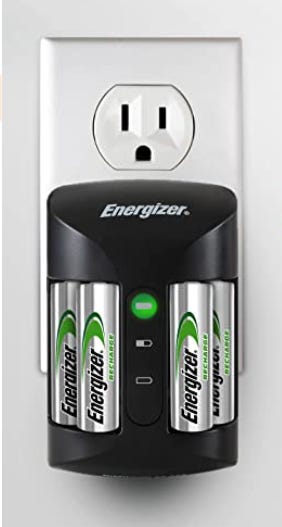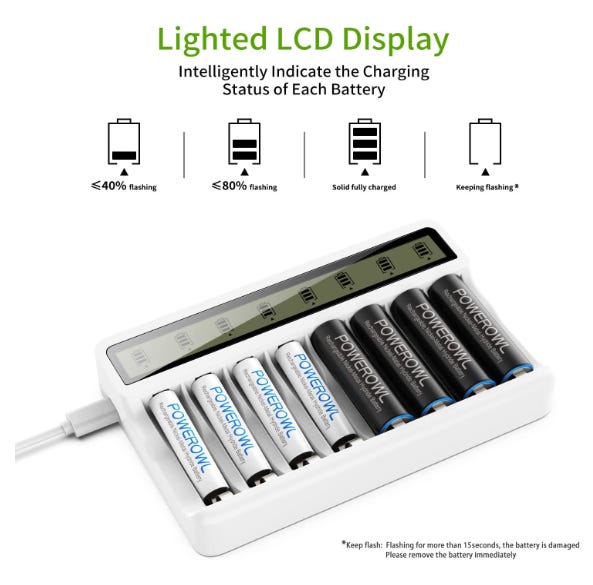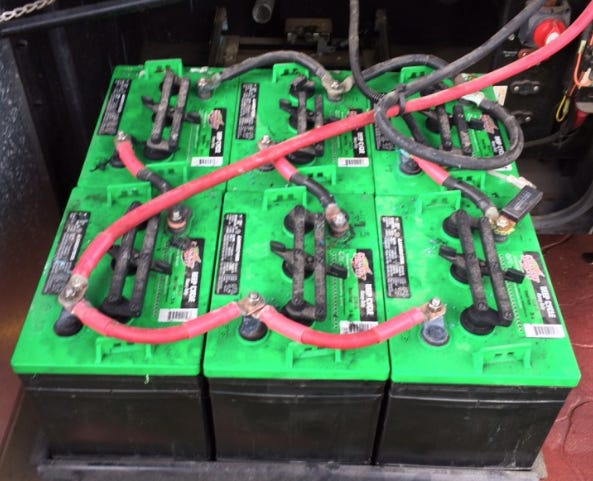My guitarist of 40+ years (Karl) called me other day asking what I knew about battery chargers. He had purchased a portable guitar amplifier that needed 8 AA rechargeable batteries. He popped in the batteries, plugged in his guitar, and the amp shut down on the first note.
The plot begins…
He dragged out an extension cord and plugged in the wall wart to get it working, but his dream of playing on battery power alone seemed to be lost.
He had charged the new batteries overnight as advised, and the charger said the batteries were full. See above for what he was using for batteries and the charger that came with them.
The plot thickens
I’ve had this exact thing happen to me with the same charger and batteries, and it seemed like the charger would shut off after the first battery reached 100% charge, and there could be other batteries in the same charger with only 50% SoC or less.
So I told Karl to check each battery individually, and that was it… While he had several batteries at 100% charge, other batteries were at 50% and one was as low as 30%. Just as I had predicted, the “dumb” charger that came with the rechargeable batteries had shut off when the first battery reached 100%, and the rest of the batteries were not fully charged. So unless every battery was at the exact same state of discharge, this type of charger would never get all of them up to 100% SoC.
What’s the solution?
Glad you asked… I found another class of “smart chargers” that monitors each battery independently, so you can charge up to 8 batteries at a time and they’ll all end up at 100% without overcharging. Here’s what I bought, and it worked perfectly for my rechargeable batteries. You can buy one on Amazon for less then $20 HERE.
Does the same sort of thing happen in your RV?
Oh yes it does. If you have multiple batteries in your RV, and they are perfectly matched in age, then a single charger will probably work just fine. However, if you accidentally let everything go flat by leaving the disconnect switch on for weeks or a month, then all batteries might not charge back up exactly the same way.
So if a complete discharge happens I think it’s the best policy to disconnect them from each other (after marking all cables and connections properly) and recharge each battery one at a time with a smart charger. And if the battery is completely dead, you might need to use a “dumb” charger on them for an hour to get the battery voltage up to the point where the smart charger can recognize it and turn on properly.
More on this later
I'll cover the differences between all the various RV chargers in a future article. But just know that not all chargers are created equal, and some can destroy your expensive batteries.
In the meantime, let’s play safe out there - Mike








Mike I clicked the link and end up confused. AA and AAA batteries are 1.5 volts. This charger says input 5 volts and output 1.4 volts. 1.4 will not charge them fully. Is this just a misprint? Thanks
When charging wet cells or AGM in parallel the current will divide and the stronger of the batteries will always take the most charge and will dictate when the charger so to speak shuts down. When charging in series both batteries will see the same current flow and charge at the same rate. If you have 4- 6 volt batteries in a series parallel connection one string will always be the better of the two. I am not that versed on the charging of lithium batteries however I would take a guess they would work the same?